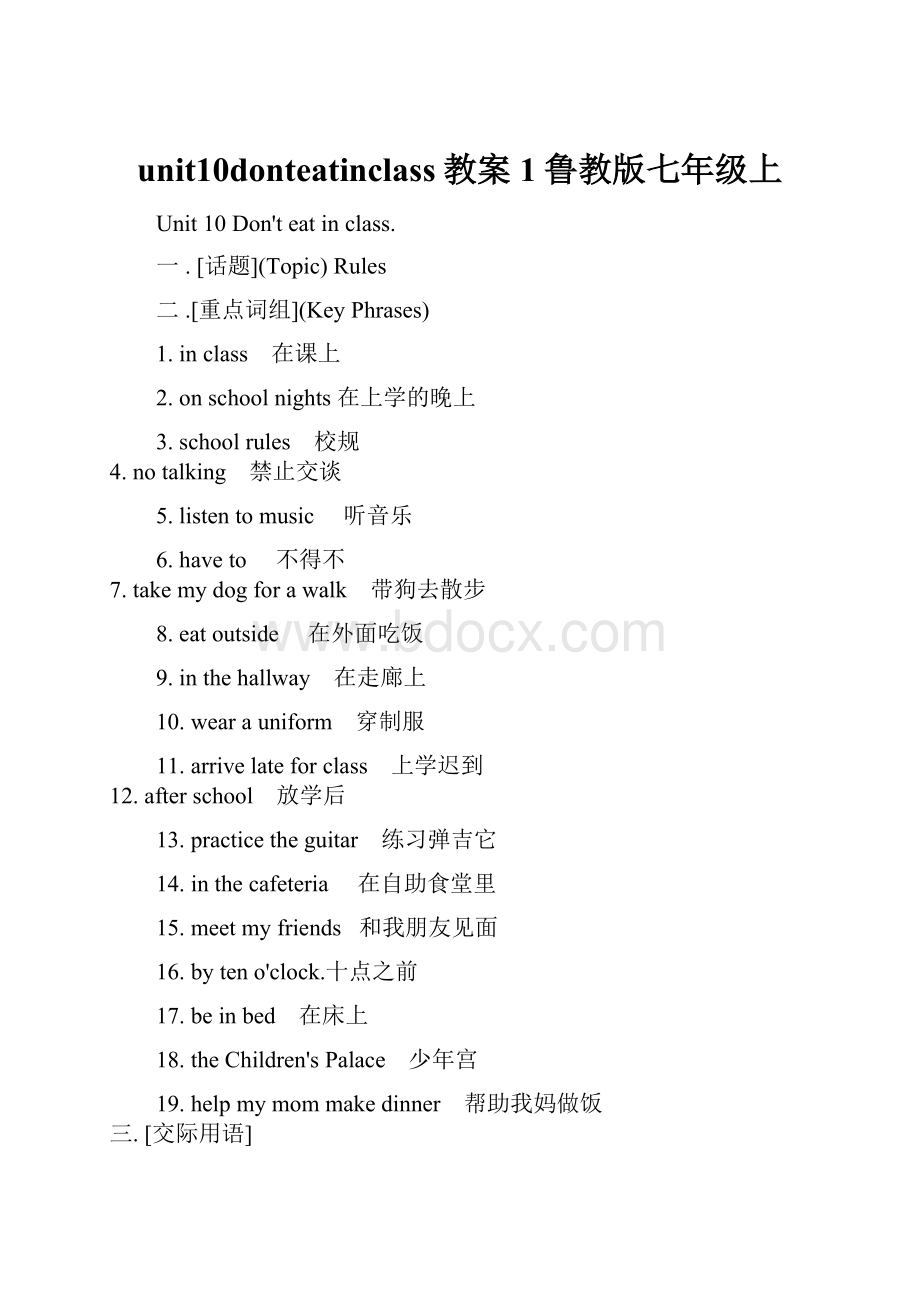unit10donteatinclass教案1鲁教版七年级上.docx
《unit10donteatinclass教案1鲁教版七年级上.docx》由会员分享,可在线阅读,更多相关《unit10donteatinclass教案1鲁教版七年级上.docx(10页珍藏版)》请在冰豆网上搜索。

unit10donteatinclass教案1鲁教版七年级上
Unit 10 Don't eat in class.
一.[话题](Topic)Rules
二.[重点词组](KeyPhrases)
1. in class 在课上
2. on school nights 在上学的晚上
3. school rules 校规
4. no talking 禁止交谈
5. listen to music 听音乐
6. have to 不得不
7. take my dog for a walk 带狗去散步
8. eat outside 在外面吃饭
9. in the hallway 在走廊上
10. wear a uniform 穿制服
11. arrive late for class 上学迟到
12. after school 放学后
13. practice the guitar 练习弹吉它
14. in the cafeteria 在自助食堂里
15. meet my friends 和我朋友见面
16. by ten o'clock.十点之前
17. be in bed 在床上
18. the Children's Palace 少年宫
19. help my mom make dinner 帮助我妈做饭
三.[交际用语]
1. What are the rules at your school?
你们学校有什么规定?
Don't run in the hallways and don't arrive late for class. 不要在走廊上跑,不要迟到。
2. Can we eat in school?
我们能在学校吃东西吗?
We can eat in the cafeteria, but we can't eat in the classroom. 我们可以在自助餐厅吃东西,但是我们不能在教室吃东西。
3. Can you wear hats in school?
你们在学校可以戴帽子吗?
Yes, we can. / No, we can't. 是的,我们可以。
/不,我们不可以。
4. Do you have to wear a uniform at school?
你们在学校不得不穿校服吗?
Yes, we do. / No, we don't. 是的,我们要穿。
/不,我们不穿。
5. What else do you have to do?
你还有别的不得不做吗?
We have to clean the classrooms.
我们不得不打扫教室。
四.[重点难点释义](LanguagePoints)
1. 情态动词have to 的用法,意思是"必须、不得不",它侧重于客观上的必要和外界的权威。
(1)结构:
主语+have to+动词原形+其他
(一般现在时,主语是第三人称单数时,用has to;句子是过去时,用had to.)如:
We have to wear sneakers for gym class. 在体育课上,我们必须穿运动鞋。
Tom has to practice the guitar every day. 汤姆每天必须练习弹吉它。
I had to get up at 5:
00 am last Monday. 上周一,我不得不早上5点起床。
(2)否定形式:
主语+don't have to+动词原形+其他
(一般现在时,主语是第三人称单数时,用doesn't have to. 句子是过去时,用didn't have to)
如:
Nick doesn't have to wear a uniform. 尼克不必穿制服。
We didn't have to do our homework at once. 我们不必马上完成作业。
(3)疑问句:
Do (Does或Did)+主语+have to +动词原形+其他
如:
Do you have to stay at home on weekends?
周末你必须呆在家里吗?
Yes, I do. / No, I don't.
是的,我必须。
不,我不必。
Did he have to go to bed by 11:
00 last night?
昨晚,他不得不11点前上床睡觉吗?
2. 情态动词can的用法
(1)表示能力,"会""能"(在第一册中已经学习这种用法)
Can you play the guitar?
你会弹吉它吗?
Judy can speak a little Chinese. 朱蒂会说一点中文。
I can dance and sing. 我能唱歌又能跳舞。
(2)表示允许、许可,"可以"、"能"(在这一课中新学的词义)
Can the students run in the hallways?
学生们可以在走廊上跑吗?
We can eat outside. 我们可以在外面吃东西。
Can I come in?
我能进来吗?
注意 同样是情态动词,can 和have to 的用法是有区别的,和大部分情态动词一样,can在否定句中,直接在can后加上not,在疑问句中,把can放到主语前面,并且没有人称和数的变化。
3. hear,listen和sound都有"听"的意思,但三者是有区别的。
(1)hear"听说",侧重于"听"的内容
I'm sorry to hear that you are ill. 听说你生病了,我很难过。
I never heard such an interesting story. 我从来没听过这么有趣的一个故事。
(2)listen"听"侧重于"听"这一动作。
Listen to me carefully. 认真听我说。
The children like to listen to music. 孩子们喜欢听音乐。
(3)sound"听起来",它是系动词,后面接形容词等。
That sounds great. 那听起来真不错。
It sounds like fun. 听起来挺有趣。
4. be in bed "在床上、卧床"in 和bed之间不能用冠词,bed也不用复数。
He is in bed for 10 years. 他卧床10年了。
Dave has to be in bed early every night.大卫每晚必须很早睡觉。
5. arrive late for 与be late for 意思相近,"迟到"Don't arrive (be)late for school. 上学别迟到。
I arrived (was)late for the meeting yesterday. 我昨天开会迟到了。
6. No talking !
"禁止交谈!
"no后面加上名词或动名词(doing)也表示不要做某事。
与don't +do的用法相似。
No wet umbrellas!
/ Don't put wet umbrellas here!
禁止放湿雨伞!
No food!
Don't eat food here!
禁止吃食物!
No smoking!
Don't smoke here!
禁止吸烟!
7.....listentomusicoutside.……在外面听音乐。
outside在该句中为副词,表示“在外”,“向外”的意思。
如:
It'sdarkoutside.外面很黑。
此外还有几种用法:
outside还可用作名词,指“外部”。
如:
Theoutsideofthebuildingiswhite.建筑物的外面是白色的。
outside用作形容词,“外边的”。
如:
Outsidepeopleknownothingaboutit.局外人对此一无所知。
outside还可用作介词,“外部”,“在......”外面”。
如:
Myteacherparkedhiscaroutsidethegate.我的老师把车停在了校门外。
outside的反义词为inside。
8.--Whataretherules?
有什么规章制度吗?
--Well,wecan'tarrivelateforclass.嗯,我们上课不能迟到。
(1)can是情态动词,可以表示“可以,允许”,can't则表示其否定意义“不可以,不能”。
如:
--CanIsmokehere?
我可以在这里抽烟吗?
--Sorry,youcan't.对不起,你不能。
Wecanlistentomusicoutside.我们可以在外面听音乐。
(2)arrivelate“迟到”的意思,belatefor...也可表示“做某事迟到”。
如:
Iarrivedlateforworkyesterdaymorning.昨天上午我上班迟到了。
Areyouoftenlateforschool?
你上学经常迟到吗?
9.AndIhavetobeinbedbyteno'clock.十点钟前我就得上床睡觉。
(1)haveto表示“必须,不得不”的意思,表示客观的需要,后接动词原形。
don'thaveto表示“不必”。
(2)haveto,hasto,hadto的疑问句和否定句要使用借助词do,does或did。
如:
--Whatdowehavetodo?
我们必须做什么事?
--Youhavetofinishyourhomework.你们必须完成作业。
--Doyouhavetocomehereby8:
00tomorrow?
你们明天八点钟之前必须赶到这里吗?
--Yes,wedo.是的。
--Doesshewashalltheclothes?
她必须洗所有的衣服吗?
--No,shedoesn't.没有必要。
(3)beinbed“卧床”,“睡觉”。
如:
Hewasinbedalldayyesterday.他昨天一整天都没有起来。
(4)by在此句中为介词,意思是notlaterthan“最迟在……”。
如:
I'llbebackby6o’clock.我最迟六点钟回来。
10.Ihavetoomanyrulesinmyhouse.我家有太多的家规。
(1)动词have是个用法较活的词,表示“有”,第三人称单数形式是has。
在英国英语中,have意为“拥有”。
构成疑问句时把have提到主语前面,表示否定时,在其后面加not,可缩写为haven't。
如:
--Haveyouapen?
你有钢笔吗?
--Yes,Ihave.ButIhaven'tanewone.是的,我有。
但我没有新钢笔。
在美国英语中,除上述用法外,还可以用助动词do/does来构成疑问句和否定句。
如:
--Doyouhaveakite?
你有风筝吗?
--Yes,Ido.我有。
Hedoesn'thaveanything.他没有任何东西。
注意区别have和therebe:
have与therebe都可以作“有”解。
①have用来表示各种关系的“所有”,身上“具有(说明人物的外观)”和整体与局部的“含有”。
如:
Ihaveagoodfriend.我有一位好朋友。
Hasthebookaredcover?
这本书的封面是红色的吗?
②therebe表示存在的关系,表示某处有某人或某物时常用这种句型。
Therearetwobikesunderthetree.树下有两辆自行车。
Therearefortystudentsinourclass.我们班有四十名学生。
③当表示整体与局部的“含有”时或者是难以判断“有”是所属关系还是存在关系时,have和therebe均可使用。
如表示“一年有十二个月”:
Ayearhastwelvemonths.
Therearetwelvemonthsinayear.
注意:
在therebe结构中,如果主语不止一个,谓语动词往往和与之最接近的主语在数上保持一致,即我们常说的就近原则。
如:
Thereisapen,twopencilsandfourbooksonthedesk.
桌子上有一支钢笔,两支铅笔和四本书。
Therearetwomapsandapictureonthewall.
墙上有两张地图和一幅画。
(2)toomanyrules“太多的规定”,其中toomany用来修饰可数名词rules。
Hehastoomanyfriendstomeet.他有很多朋友要见。
修饰不可数名词时,要用toomuch。
如:
Wehavetoomuchworktodo.我们有许多工作要做。
五.语法知识
祈使句表示请求、命令、建议等等。
谓语动词一律用原形。
句子中通常不用主语,句末用惊叹号或者句号,用降调。
1含有第二人称主语的祈使句
Becareful!
小心!
Don'tmakesuchanoise.不要这么吵。
1.肯定的祈使句
a.句型:
动词原形~.(省略主语)
Standup.起立。
Bequiet,please.请安静。
b.有时,为了加强语气,可以在动词之前加do
Dositdown.
务必请坐。
Dostudyhard.
一定要努力学习。
比较
祈使句和陈述句陈述句:
Yousitdown.
你坐下来。
祈使句:
Sitdown.坐下
(省略主语you)
c.用客气的语气表示祈使句时,可在句首或句尾加上please,但如果在句尾加please,那在please之前一定要加一个逗号“,”。
Gothisway,please.
请这边走。
d.祈使句中如果有唤语,一定要用逗号“,”隔开,放在句首或句尾。
LiMing,comehere.
李明,过来。
Comehere,LiMing.
过来,李明。
2.否定的祈使句
句型:
Don't+动词原形~
Don'tswimintheriver.
别在河里游泳。
Don'tbelate.别迟到。
Pleasedon'tbenoisy.
请不要大声喧哗。
注意
表示禁止时,尤其是标语等也可用“No+动名词”来表示。
Nosmoking.
禁止吸烟。
Noparking.
禁止停车。
句型转换
祈使句与陈述句的改写
1.祈使句=Youmust…(陈述句)
Comehere.过来。
=Youmustcomehere.
你必须过来。
Don'tdothatagain.
你一定不可以再那样做了。
2.Please+祈使句=Willyou(please)~?
(陈述句)
Pleasehelpme.请帮帮我。
=Willyou(please)helpme?
你愿意帮我的忙吗?
Comehereontime,please.请准时到这儿。
=Willyou(please)comehereontime?
请你准时到好吗?
3.含有第一、第三人称主语的祈使句
Let'ssaygood-byhere.
我们在此道别吧。
Don'tlethimdothatagain.
别让他再那么做了。
4.肯定的祈使句
句型:
Let+第一人称(me,us)~.
Let+第三人称代词(宾格:
him,her,it,them)或名词~.
Let'sgoatonce.
咱们马上动身吧。
Letmetryagain.
让我再试试。
LetTomgotherehimself.
让汤姆自己去那儿。
注意:
Let's包括对方,Letus不包括对方。
反意疑问句时最明显。
Let'sgo,shallwe?
咱们去吧,怎么样?
Letusgo,willyou?
让我们去吧,行吗?
(征求对方的意见)
5.否定的祈使句
句型:
Let's(us,me)+not+动词原形.
Don'tlet+第三人称代词的宾格或名词+动词原形.
Let'snotsayanythingaboutit.
对于这件事,咱们什么也不要说。
Don'tletthemplaywithfire.
别让他们玩火。
句型转换
祈使句有时相当一个if引导的条件状语从句。
祈使句:
Useyourheadandyou'llfindaway.
条件句:
Ifyouuseyourhead,you'llfindaway.
如果你动动脑筋,你就会找到方法。
注意
回答Let's...的反意疑问句句型时,肯定时用Yes,let's.否定时用No,let'snot.